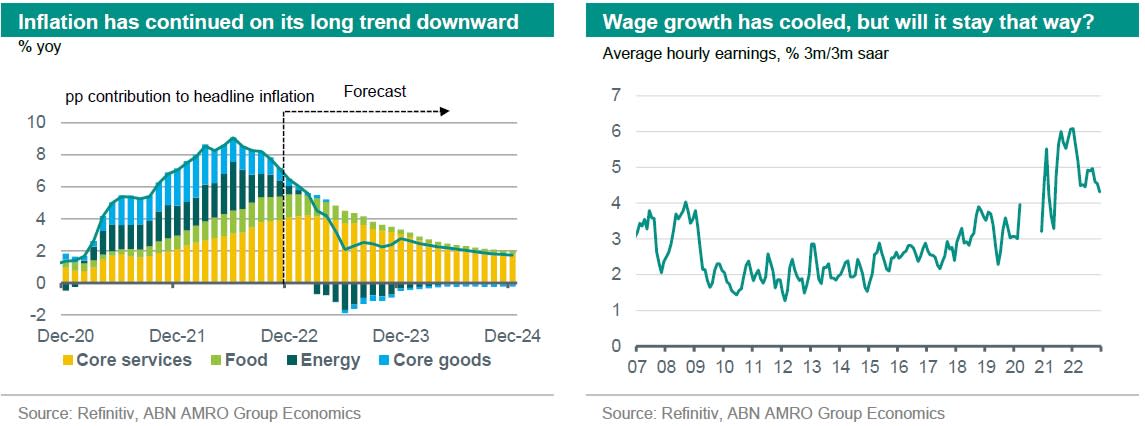US - Goldilocks, is that really you?

Sharply falling inflation coincided with surprisingly strong growth in Q4. This triggered comparisons to the pre-pandemic ‘goldilocks’ period, when the tight labour market was non-inflationary. While a benign, soft landing scenario has become more likely, we still think the Fed will want to see a significant weakening in the labour market before it is confident the inflation battle is won. Weak activity data towards the end of Q4 suggests we are on the cusp of such a weakening, and this will support our expectation for significant Fed rate cuts later in the year.
Since our Outlook last month, inflation has continued its long trend downward; as of December, both headline and core measures are well off their June peaks, and are now the lowest they have been in a year. While uncertainty remains over where inflation ultimately lands, we are confident the trend will be downward over the coming months. The drivers of falling inflation are still very much in play: 1) cooling domestic demand, 2) the recovering supply side, 3) the easing in global pipeline pressures. With that said, risks to the outlook are still significant. Labour hoarding has meant that the slowing in jobs growth, and the decline in vacancies, has been more sluggish than we expected. In recent months, the still-tight labour market has led to remarkably little wage inflation, and the most recent wage growth readings have been consistent with the pre-pandemic trend. Still, the Fed will not take its chances, and the Committee will need to see a rise in unemployment and a significant fall in job vacancies before it is confident the inflation battle is won. Goldilocks is unlikely to stick around.

As if to underline this, the otherwise strong Q4 ended on a very weak note. December retail sales and industrial production fell by -1.1% m/m and -0.7% respectively, with November data also downwardly revised. The decline in retail sales was broad-based. This followed a very strong October, meaning private consumption is still likely to have made a solid gain in Q4 when GDP data are released this week. Industrial production in contrast declined over the quarter, driving capacity utilisation to its lowest level in a year, at 78.8%. This increase in spare capacity appears to be constraining producer pricing power, which helps explain the drop in producer prices. The hard data now appear to be moving more in line with what the PMIs had signalled for some months, and this suggests that following the bounce in GDP in Q4, we are likely to see a decline in output in Q1, which would be in line with our base case. For Q4, however, we now expect growth of around 2.5% annualised, up significantly from our initial expectation of 1%. As a result, we have raised our 2022 GDP forecast marginally by 0.1pp to 2.0%, but there is also carry-over to 2023, with our forecast up by 0.2pp, to 0.7%.
The broad softening in activity, alongside the easing in inflationary pressure, supports our view that the Fed is approaching the end of its rate hike cycle, and that it is likely to start cutting rates by this coming September. We continue to expect a total of 125bp in rate cuts later this year, with falling inflation and weak activity the likely trigger for a reduction in policy restriction. This would take the fed funds rate down from the expected peak of 4.75-5.00% to 3.50-3.75% by year end. The key risk to this view is the sluggish pace of the labour market cooling, due to labour hoarding. We view this behaviour as unsustainable in the face of softening demand, and we continue to expect the unemployment rate to begin rising as the year progresses. But more persistent labour market strength could mean policy stays somewhat tighter for longer.
This article is part of the Global Monthly of 23 January 2023
